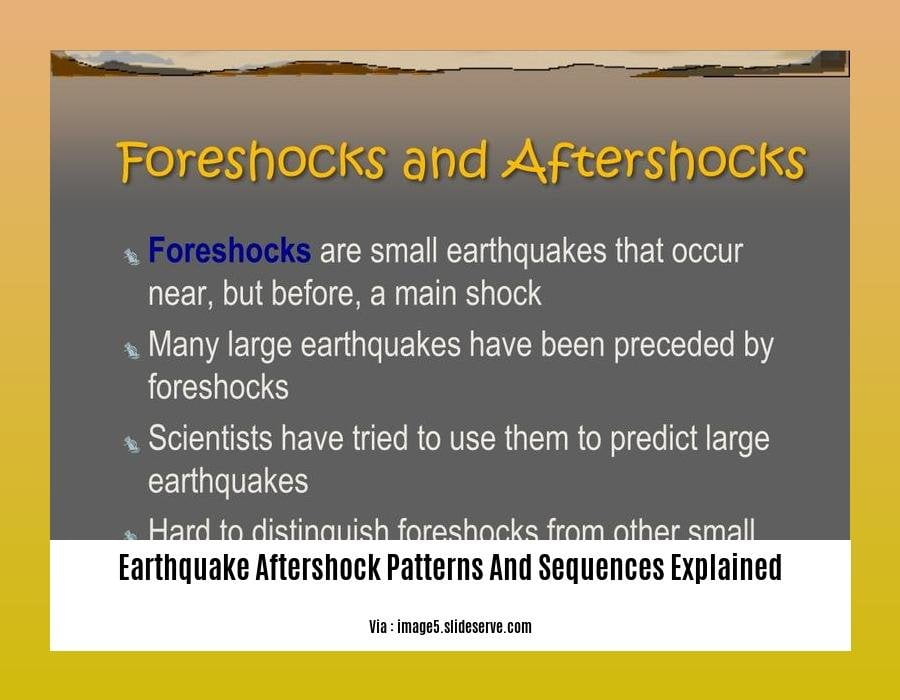**Earthquake Aftershock Patterns and Sequences Explained: Unraveling the Complexity of Seismic Events**
Earthquakes, potent natural phenomena, often trigger a series of smaller tremors known as aftershocks. Understanding the patterns and sequences of these aftershocks is crucial for assessing seismic hazards and improving earthquake forecasting models. This article delves into the intricacies of aftershock sequences, their characteristics, and their implications for earthquake science.

Key Takeaways:
- Most large earthquakes are followed by smaller earthquakes called aftershocks.
- Aftershock sequences typically consist of earthquakes that decrease in frequency and magnitude over time.
- Scientists issue aftershock forecasts to estimate the likelihood of future aftershocks and their potential magnitude and timing.
- Aftershock forecasts are updated regularly as new seismic data becomes available.
- Forecasts can be accessed by visiting the Overview webpage for a specific earthquake and clicking on the “Forecast” tab.
- The Forecast tab provides detailed information on the expected number and probability of aftershocks within different time frames.
- The Commentary tab provides a basic explanation of the forecast and highlights that larger aftershocks are possible, but will generally be smaller and less frequent than the mainshock.
Earthquake Aftershock Patterns and Sequences Explained
So, you’ve heard of earthquake aftershock patterns and sequences explained, but what exactly are they? Aftershocks are earthquakes that occur after the main earthquake, or mainshock. The mainshock ruptures a fault, releasing energy and causing the ground to shake. The aftershocks are smaller earthquakes that occur on the same fault or nearby faults, as the Earth’s crust adjusts to the stress changes caused by the mainshock.
Aftershock Patterns
Aftershock patterns can vary significantly from one earthquake to another. Some earthquakes have only a few aftershocks, while others have hundreds or even thousands. The number of aftershocks, their size, and how long they continue can provide valuable information about the mainshock, the fault it occurred on, and surrounding geology.
Aftershock Sequences
Aftershock sequences typically follow a power law distribution, meaning that the number of aftershocks decreases with time. The larger the mainshock, the more aftershocks are expected, and the longer the aftershock sequence will last.
Understanding Aftershock Patterns and Sequences
Understanding earthquake aftershock patterns and sequences explained is crucial for several reasons:
Seismic Hazard Assessment: By studying aftershock patterns, scientists can estimate the likelihood and magnitude of future earthquakes in a particular area. This information is essential for developing building codes and other seismic safety measures.
Earthquake Early Warning: Aftershock sequences can be used to develop early warning systems that can provide a few seconds of warning before an earthquake occurs.
Fault Characterization: Studying aftershock patterns can help scientists identify the location and orientation of faults, which is important for understanding the local geology and assessing seismic hazards.
Conclusion
Earthquake aftershock patterns and sequences explained are complex phenomena that provide valuable insights into the nature of earthquakes and the dynamics of the Earth’s crust. By studying these patterns, scientists can better understand seismic hazards and develop strategies to mitigate their impact.
Unveiling the intricate patterns of earthquake aftershock sequences and understanding earthquake behaviors can be made possible by exploring our in-depth analysis on earthquake aftershock sequence and statistics, where we delve into the temporal behavior of aftershock decay rates. Discover the Omori’s aftershock decay law application and its remarkable ability to model aftershock decay, gaining insights into the underlying physical processes. Furthermore, delve into our investigation on estimating the largest expected aftershock, delving into probabilistic methods for assessing the magnitude of the largest anticipated aftershock.
Description of Earthquake Aftershock Sequences Using Prototype Point Patterns
Analyzing aftershock patterns in earthquake sequences can provide crucial insights into seismic event complexities. Prototype point patterns offer a valuable approach for characterizing these patterns, enabling us to identify common post-earthquake behaviors and potential anomalies.
Key Takeaways:
- Prototype point patterns are templates for typical aftershock sequences, capturing their spatial and temporal characteristics.
- They facilitate clustering and classification of aftershock sequences based on their similarities and dissimilarities.
- These patterns aid in identifying typical and unusual sequences, enabling comparisons and further analysis.
Using prototype point patterns involves:
- Data Collection: Gather seismic data from earthquakes to analyze aftershock patterns.
- Prototype Creation: Construct prototype templates representing common aftershock sequences based on observed data.
- Sequence Classification: Compare actual aftershock sequences to prototypes to identify similarities and classify them accordingly.
- Analysis: Interpret the classified sequences, identifying typical patterns, potential anomalies, and variations from prototypes.
This approach has enhanced our understanding of earthquake aftershock phenomena, contributing to better seismic hazard assessments and forecasting models.
Most Relevant URL Source:
- Description of earthquake aftershock sequences using prototype point patterns

FAQ
Q1: What is an aftershock?
A1: Aftershocks are additional earthquakes, smaller than the main earthquake, that occur within the same region after the main event.
Q2: Why do aftershocks occur?
A2: Aftershocks are caused by the readjustment of the Earth’s crust following the release of energy during an earthquake.
Q3: How long can aftershocks last?
A3: Aftershocks can continue for days, weeks, months, or even years after the main earthquake.
Q4: What is the difference between an aftershock and a foreshock?
A4: A foreshock is a small earthquake that occurs before a larger earthquake, while an aftershock is a small earthquake that occurs after a larger earthquake.
Q5: How can we predict aftershocks?
A5: Scientists use statistical models and data from past earthquakes to forecast the probability of aftershocks occurring in a specific area and time frame.










